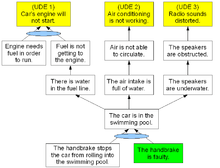Current reality tree (Theory of constraints)
One of the thinking processes in the theory of constraints, a current reality tree (CRT) is a way of analyzing many systems or organizational problems at once. By identifying root causes common to most or all of the problems, a CRT can greatly aid focused improvement of the system. A current reality tree is a directed graph.
Simplified explanation
A CRT is a focusing procedure formulated by the late Eliyahu Goldratt, inventor of the theory of constraints. This process uses time-tested rules of logic to help leaders - in a few brief, but intensive sessions - gain a deep understanding about what really matters in any given situation. It treats multiple problems in a system as symptoms arising from one or a few ultimate root causes or systemic core problems. It describes, in a simple visual (cause-and-effect network) diagram, the main perceived symptoms (along with secondary or hidden ones that lead up to the perceived symptoms) of a problem scenario and ultimately the apparent root causes or core conflict. The benefit of building a CRT is that it is much easier to identify the connections or dependencies between perceived symptoms (effects) and root causes (core problems or conflicts). If core problems, for example in complex situations or crises, are identified, prioritized, and tackled well, multiple undesirable effects in the system will disappear. Thus, leaders may then focus on the bits, the few core problems, which would cause the biggest positive systemic changes, if tackled.
Contextual explanation
A CRT is a statement of an underlying core problem and the symptoms that arise from it. It maps out a sequence of cause and effect from the core problem to the symptoms. Most of the symptoms will arise from the one core problem or a core conflict. Removing the core problem may well lead to removing each of the symptoms as well. Operationally working backwards from the apparent undesirable effects or symptoms to uncover or discover the underlying core cause.[1] [2] [3]
Example

A CRT begins with a list of problems, known as undesirable effects (UDEs.) These are assumed to be symptoms of a deeper common cause. To take a somewhat frivolous example, a car owner may have the following UDEs:
- the car's engine will not start
- the air conditioning is not working
- the radio sounds distorted
The CRT depicts a chain of cause-and-effect reasoning (if, and, then) in graphical form, where ellipses or circles represent an "and". The graphic is constructed by:
- attempting to link any two UDEs using cause-and-effect reasoning. For example, "if the engine needs fuel in order to run and fuel is not getting to the engine, then the car's engine will not start."
- elaborating the reasoning to ensure it is sound and plausible. For example, "if the air intake is full of water then air conditioning is not working." Elaboration (because air is not able to circulate) gets added as in-between step.
- linking each of the remaining UDEs to the existing tree by repeating the previous steps.
This approach tends to converge on a single root cause. In the illustrated case, the root cause of the above UDEs is seen as being a faulty handbrake.
Software
- jThinker is a free tool for building TOC thinking processes diagrams including the current reality tree.
- Flying Logic is a commercial tool for building TOC thinking processes diagrams including the current reality tree.
- Southbeach is a notation and commercial tool for building many different kinds of thinking processes, including TOC and the current reality tree.
See also
References
- ↑ Dettmer, H. W., (1997) Goldratt’s Theory of Constraints: a systems approach to continuous improvement. ASQC Quality Press, pp 62-119.
- ↑ Dettmer, H. W., (1998) Breaking the constraints to world class performance. ASQ Quality Press, pp 69-102.
- ↑ Scheinkopf, L., (1999) Thinking for a change: putting the TOC thinking processes to use. St Lucie Press/APICS series on constraint management, pp 143-169.